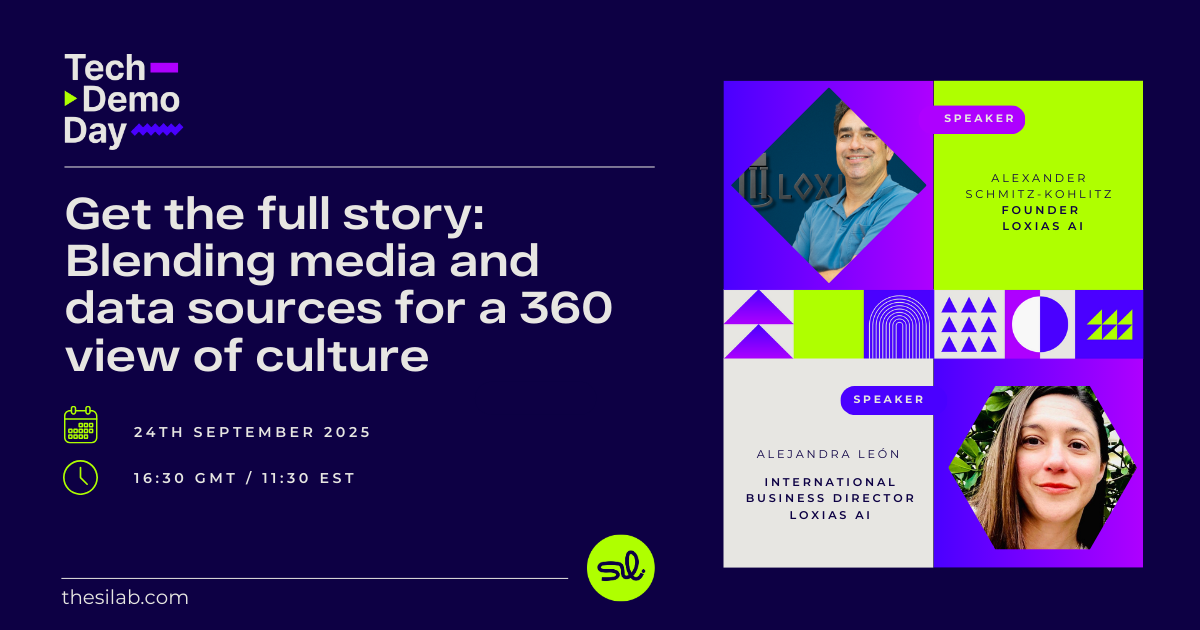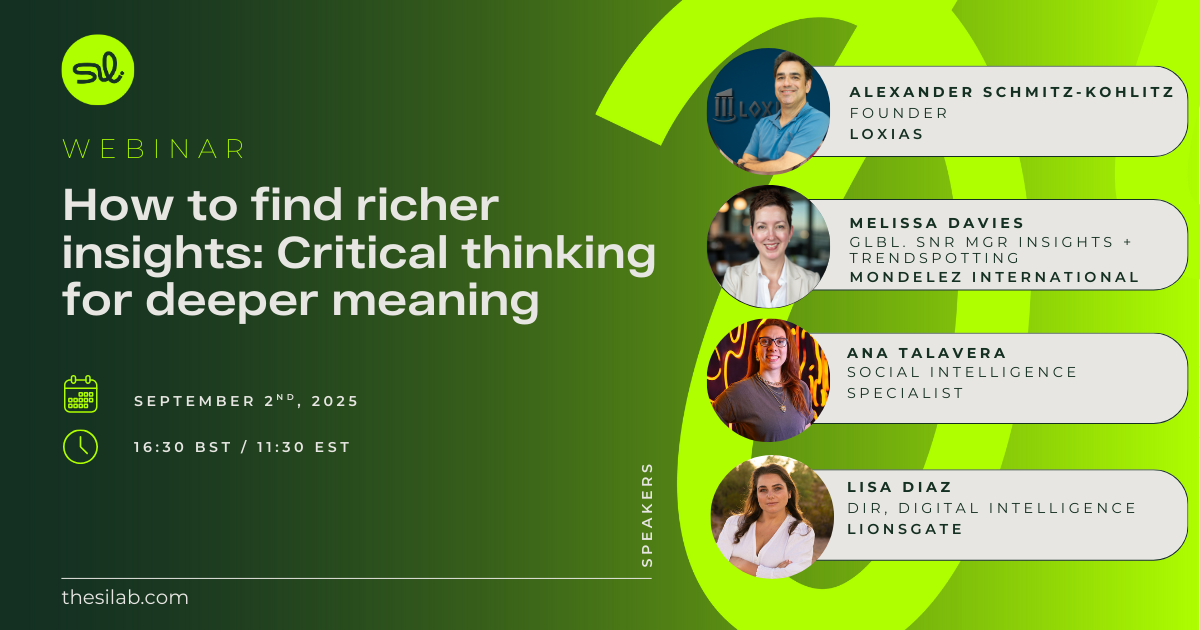.png)
How to use Snapchat for social listening
If TikTok is the goliath of social media, then Snapchat might be David? The spotlight on it is smaller, however it’s currently one of the most popular platforms among younger audiences. And its strength lies in disappearing messages. The temporary nature of the content relieves the pressure to present a curated persona and the perfect life, leaving people to be their true selves.
This is why Snapchat data offers such an incredible opportunity to understand audiences better. And many social intelligence professionals are aware of this. In the 2025 State of Social Listening, 22% of respondents listed Snapchat as a data source they’d like to use but aren’t currently. While many platforms claim to present the authentic voice of the user, when everything is shared publicly, it’s hard not to be self-conscious when posting.
Until now, it’s been difficult to analyse any Snapchat data at scale, let alone the disappearing bits. However, that’s changing. Even though private messages will likely (and hopefully!) never be available for analysis, publicly shared content is now available through certain social listening platforms.
So, let’s go deeper into Snapchat to learn why it’s so interesting for social intelligence professionals and how we can use it, even with limited access to the data.
Snapchat 101: What’s it all about?
Snapchat began as an image sharing app, where people could send photos to friends or individual connections that disappeared as soon as they had been viewed. It was launched in 2011 and is owned by Snap Inc. From the beginning, the disappearing picture element was central to the design.
The app has since expanded to enable live video and audio content sharing between individual users and groups, through the ‘Chat’ feature. It also allows public sharing of content through the “Stories” feature. This is similar to Instagram Stories, where content is available for 24 hours.
Snapchat is known for its innovation in features. Since 2011, it has introduced 121 product features. Some of the most popular include Smart Filters, enabling people to customise their photos, and Snap Maps, where users can share their location and see what others nearby are doing. The company, Snap Inc., also develops wearable tech such as AR glasses.
What’s the vibe?
Because the primary element of this app is to share content that disappears once it’s been seen, the vibe is more raw than on other platforms. People don’t overthink what they post and how it might be received, because it will never be seen again. That leads to a whole range of different content being shared: random thoughts and fun silly ideas but also more intimate, vulnerable content too.
There’s a strong community vibe on the platform too. The app opens on the camera rather than a content feed which encourages users to share, not only consume. In doing that, they feel more part of a community. The interactions are generally two-way. This is encouraged by things like Snapstreak - a tally of how many consecutive days two people have interacted on Snapchat - and Snap Games.
The community element extends to recommendations around different products and brands. According to Snapchat-led research, 84% of users learn about new trends and products through social media, vs 54% of non-users. And 84% of Snapchatters “trust brands more if recommended by someone like themselves.” As a result, Snapchat is increasingly used as a search engine.
What makes Snapchat different from other social data sources?
Like many social media platforms, Snapchat claims to be a more authentic place for people to connect and hang out. In fact, according to their manifesto, they aren’t trying to be a social media platform at all.
“Snapchat is not social media. It was built as an antidote to social media. Snapchat opens to a camera, and not a feed of content, so we can share our perspective easily with those who matter most to us. You know, the people we’re friends with in real life; the ones we feel comfortable sharing our full range of emotions with — the ups and downs, the good and bad — without the pressure to post the perfect thing.”
That could just be good marketing. But there is evidence that users of Snapchat feel less pressure to perform when posting. According to research from Cornell University people are more relaxed using the app than others. “In the interviews users said when friends snap each other they no longer have to worry about whether what they message will be shared with an unintended person or taken out of context…With so much to store mentally and digitally, users reported that they enjoy being able to have an interaction where they can be their true selves without worrying about the repercussions of their exchanges.”
Another way Snapchat differentiates itself from other platforms is by the number of features it incorporates, including Snap Maps, games and My AI. This takes the app from a messenger or photo sharing tool, to a place where it’s easy to spend a lot of time: gaming with online friends, researching things to do IRL, getting creative inspiration etc. This mkes it easier for people to live their lives - online and offline - through the app.
Who uses Snapchat?
Snapchat is the fifth most popular social media platform based on monthly active users (MAU), with 850m - just over half of TikTok MAUs - and the third most popular messenger service after WhatsApp and Facebook Messenger. Growth of daily active users (DAUs) has increased from 46m in Q1 of 2014 to 460m in Q1 2025, with steady growth since Q1 2019.
The largest user group is, unsurprisingly, Gen Z. The age group 18 to 24 accounts for 38% of the total audience. The next largest user group is 13 to 17, making up 19.2% of Snapchat users. As age increases, popularity declines. In terms of gender, the split is almost even, with 48.4% of users identifying as female and 50.7% identifying as male.
When it comes to usage, US adults are estimated to spend an average of eight minutes each day on the app. Younger users spend more time: those aged 18 to 24 spend, on average, 28 minutes per day on the app, while those aged 25 to 34 spend around 15 minutes per day.
Snapchat is available globally, except in China, Cuba, Iran, North Korea, Russia, Turkmenistan, South Sudan where it’s banned. India has the highest number of active Snapchat users, at 208m. This is followed by the US (106m), Pakistan (37.5m), France (27.8m) and Saudi Arabia (24.7m).
Given the original purpose of the app was to share pictures privately with specific people or groups, the majority of users are individuals. However, since the app has expanded to offer a public feed, more brands are using it to connect with young consumers. According to their own audience research, 85% of users are comfortable making purchases online, and are likely to spend more than users of other social media platforms. This makes it a good place for brands to sell…if they do it correctly.
Like any social media platform, there are bot accounts, what percentage of users they make up is unknown. In February 2023, Snapchat launched their own chatbot - MyAI - for users to interact with. By June 2023, 150m users had sent over 10bn messages to MyAI making it one of the largest consumer chatbots available.
How to access Snapchat data for social listening
What makes Snapchat data so attractive to social listening professionals, is the reason why they’ll never be able to access it. The private and personal nature of disappearing pictures sent between friends or close acquaintances give glimpses of people when they’re being their truest self. But this data will never be available publicly.
However, some of the more carefree and honest vibes carry through to the public feed, so it’s still possible to get a different perspective on Gen Z and younger audiences than on other social media platforms.
Snapchat has recently launched a Public Profile API which allows access to content coming from public profiles, including Stories and Spotlight videos. To date (July 2025, the only social listening platform to have access to this is Meltwater. This integration was announced in February 2025 and allows their users to view post and profile-level Snapchat metrics like views and engagement, and gain insights on topics, sentiment and more.
Snapchat also developed their own social listening tool in 2021 called Snapchat Trends. This focuses on highlighting trends across public content and is able to track popular keywords, how often they were used and other metrics. This is targeted towards marketers looking to understand their audiences on Snapchat better.
What are the main use cases for Snapchat data
Snapchat data can support a lot of use cases, particularly for brands looking to target younger audiences. They include:
- Ad & campaign performance
- Audience segmentation & discovery
- Brand trust & credibility analysis
- Consumer advocacy & brand loyalty
- Consumer behaviour & decision-making
- Content performance & optimisation
- Competitive benchmarking
- Crisis detection & response
- Cultural & societal trend analysis
- Customer experience & satisfaction
- Hashtag & UGC (user-generated content) performance
- Influencer impact & credibility
- Market & industry trends
- Misinformation & disinformation detection
- Online reputation management
- Opportunity identification (engagement/comms)
- Product & service insights
- Viral trends detection & amplification
What’s next for Snapchat?
Snapchat have already embraced AI, perhaps more than other social media platforms. And they’ve hinted that in 2025 it will continue to play a role. As the company plans to differentiate themselves from competitors around visual communication, they’re looking at ways to incorporate AI into their existing augmented reality features. According to Snap CEO Evan Spiegel, “...as we look at the way that people are interacting with My AI, by sending snaps and either receiving snaps or a chat response in return. I think that starts to show the way that these multimodal models are going to play a powerful role in people’s lives. I think looking even longer term beyond that, the way that people are going to integrate AI into augmented reality, and I think provide a totally new user interface powered by AI is something that we’re investing a lot in.”
For social intelligence professionals, this means visual analysis, and in particular semiotic analysis of the cultural context that surrounds shared imagery, is going to become increasingly important.
Stay tuned for more
Snapchat offers a glimpse behind the curtain of what Gen Z and Gen Alpha are thinking, albeit one snap at a time and for a limited period. But the unvarnished and open nature of the content make it a valuable data source for social intelligence professionals, even if you only have limited access.
With this, you should now have a better idea of how to use Snapchat data for social listening, the use cases that it can support and the challenges you’re likely to face trying to use it at scale. As with the other posts in this series, this is a work in progress. Given how fast the internet changes, this article is probably already out of date by the time you’re reading it! So, if you spot anything that’s changed or hasn’t been included, feel free to let us know and we’ll fix it in the next edit.
And to make sure you receive content like this straight to your inbox as soon as it’s available, make sure to subscribe to our newsletter.
This interview was recorded via LinkedIn Live, if you prefer to view on LinkedIn, click the button below.
View InterviewSee related content
.png)








.jpeg)


